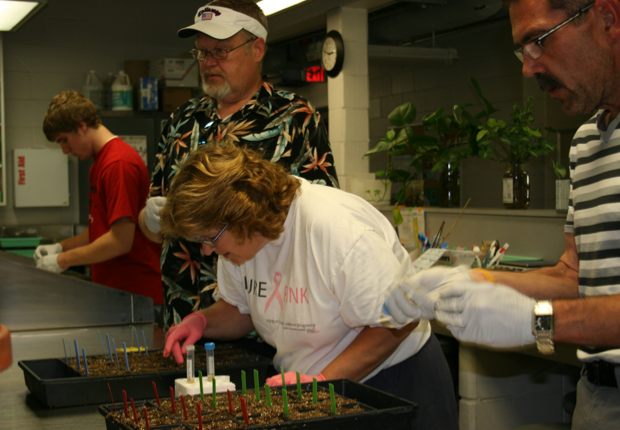
Soybean plants grow on 5.35 million Nebraska acres and are in line for a record-breaking 2010 harvest, but what intrigues Maxey Elementary schoolchildren are the legumes growing in their classrooms.
After all, soybean, while relevant to Nebraska, is a model organism that can promote understanding of real science, say collaborators of a soybean education project that brought Maxey teachers into UNL laboratories to work alongside university faculty.
"I love the fact that we had the opportunity to be involved in a real research project and follow basically the same scientific process the scientists follow," said Dwight Thiemann, Maxey fourth-grade teacher. He said he appreciates getting ideas for his science curriculum and that "the kids are loving this."
His fourth-graders enthusiastically make statements such as "I didn't even know what a soybean looked like" and "This is so cool. It's kind of like we're farmers ... kind of." Said another, "I've never planted a farm plant before."
Coordinating the soybean in the classroom project are Tiffany Heng-Moss, associate professor of entomology in the College of Agricultural Sciences and Natural Resources, and Jon Pedersen, professor of Teaching, Learning and Teacher Education in UNL's College of Education and Human Sciences. They sought and received project funding from the Nebraska Soybean Board and the United Soybean Board.
Three Maxey teachers worked in laboratories with Heng-Moss, geneticist Tom Clemente, director of the Plant Transformation Core Research Facility, and other UNL scientists. They and two more Maxey teachers currently integrate soybeans into their curriculum.
"We engage teachers in research and they in turn are engaging their elementary students in research," Heng-Moss said. "We are helping them to integrate what they learned into their science curriculum, provide first-hand opportunities for their students, and educate students on the importance of soybeans and agriculture."
That's important when agriculture is the state's No. 1 industry and where one in three Nebraska jobs are related in some way to agriculture. In 2009 Nebraska ranked fifth nationally in soybean production, valued at more than $2.4 billion. This year's soybean harvest is forecast at 284 million bushels.
Not only does the project teach children about plant parts and how they grow, Pedersen said, it teaches them about Nebraska agriculture important as people today are less informed about their food's origins.
Soybean is part of daily life, being processed into food for animals and humans, and products from fuel to crayons.
The project provides seeds, soil, plant stands, trays, lights and a time-lapse camera to be shared by the school's kindergarten, first- and fourth-grade classrooms.
"When we make science more relevant in a child's life, it's retained and more meaningful," Pedersen said. The concept of using the commodity crop, rather than green beans or lima beans, to teach science in the classroom could go regional, statewide or even national, he added.
Heng-Moss and Pedersen say the soybean science links up with state education standards so it is credible with schools.
"Any part of a solid curriculum has to be critical thinking and decision making," Pedersen said. A teacher's job isn't to tell students what to know, he said, but to help them think and use knowledge to make informed decisions.
By working with UNL scientists, teachers are able to pass on knowledge to their students about research to help soybean resist aphids and disease, and to emphasize traits such as protein or oil levels.
Greg Tebo, Maxey technology specialist, said children also learn about soybean from coloring contests, singing songs and writing puppet plays. From teachers, children learn about soybean farming, processing, transportation, exportation and end uses.
"From our work with the UNL scientists this summer we are able to provide our students with a wealth of knowledge about every facet of soybeans, from what the breeder does with the plant to the entomologist's role with the soybean aphid to the biotechnology involved with the future of soybeans," Tebo said.
- Cheryl Alberts, IANR News Service